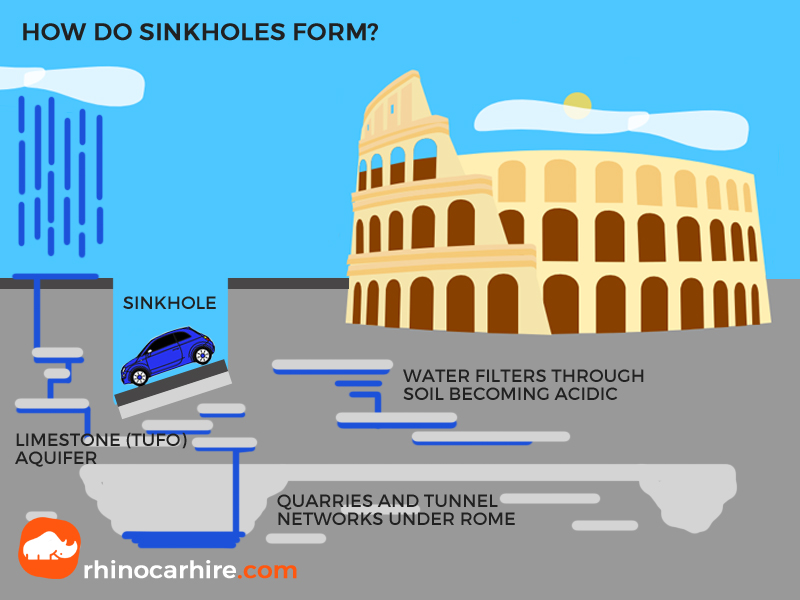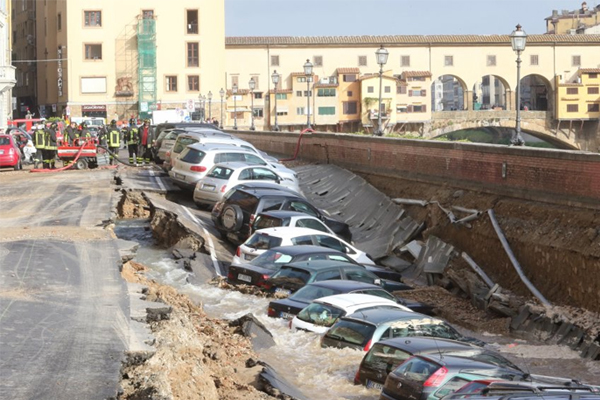Rome is Italy’s capital and a city well known for it’s influential and astounding architecture. Rome’s Geological good fortune meant it could build structures never before imagined. Underneath the city lie expansive quarries that house the building materials that led to Rome’s success: Tufo is a porous rock of volcanic origin and one of the first building materials used by the Romans. This material produced a type of concrete that enabled the Roman’s to build their empire.
Today many of the city’s iconic structures and well-visited tourist destinations, such as The Colosseum, The Forum and St Peter’s Basilica have their foundations based in this ancient building material. As wonderful and technologically advanced as this material once was, it is causing problems for modern Rome in the form of sinkholes.
How do sinkholes form?

Sinkholes are forming at an astounding rate across Rome with a reported 80+ sinkholes in the past year. These large openings in the ground are often caused by water erosion and are especially apparent in limestone formations, the crumbly volcanic ash like material found across Rome.
The pace of collapse in Rome is rising. Leaving officials and locals worried about how to prevent further collapses in the future. The quiet suburb of Aventine Hill in Central Rome left residents a gasp when a giant sinkhole opened up while they were sleeping. Following archaeological investigations it has been discovered that Aventine Hill lies on top of an ancient quarry; a worry for its residents but a fascinating opening for further archaeological study. Sinkholes such as this provide a detailed insight into an underworld in Rome that many didn’t know existed.
The sinkholes cause tremendous amounts of damage and have been known to swallow up cars and buildings. They also disrupt services such as gas, water and electric. The most recent sinkhole to cause chaos in Italy was in the city of Florence, where a huge sinkhole measuring 200 metres opened up and swallowed cars; luckily there were no injuries. The sinkhole was due to a large aqueduct pipe breaking, causing water erosion to the road.

Further sinkholes have opened up around the city, including a car being swallowed up on the via Ruggero Di Lauria in the Vatican and another one on via Palestro, close to Rome’s busy Termini Station. Residents of Rome are rightly worried and have been asking the Mayor to confirm if the roads are safe.
There is a real worry that the foundations and building materials that caused Rome to be so great are also contributing to these small natural disasters, leaving in their wake a huge amount of disruption, costly water losses and potential for serious injury.
As Tourists walk around the many attractions of Rome, they are left largely unaware of the maze of ancient quarries that lie beneath their feet. However it is these ancient quarries that are threatening the safety of the city and the preservation of its modern roads and buildings. If there is one positive to come from this ever increasing pace of openings of sinkholes around the city, it is the research that they enable. Geologists, archaeologists and a range of other scientists are learning more about subterranean Rome through the opening of the sinkholes. The use of 3D scanning equipment has shown detailed maps of the ground beneath the city and has provided a rich insight into the way the city was constructed. It is the hope that such investigations will in the future be able to limit and ultimately prevent further sinkholes from opening up unexpectedly.